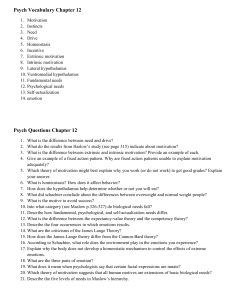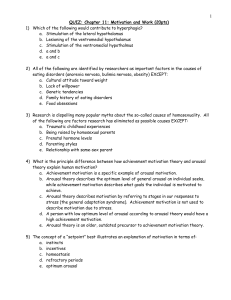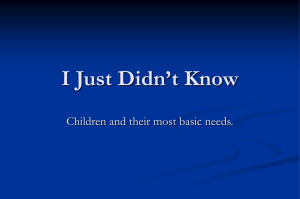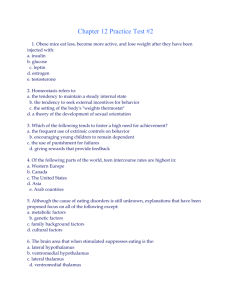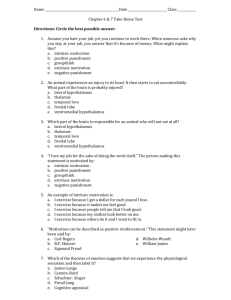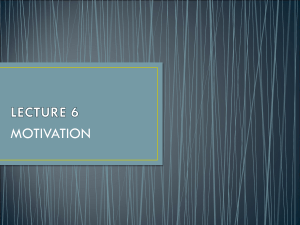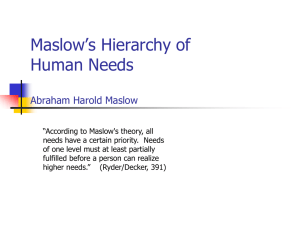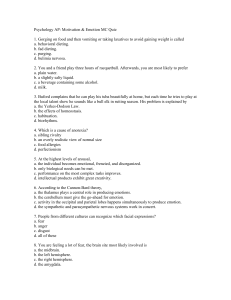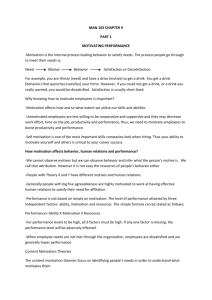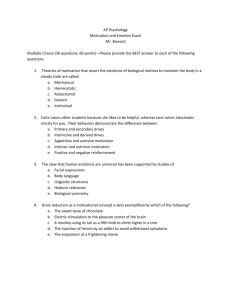answer - Easy Peasy All-in
advertisement
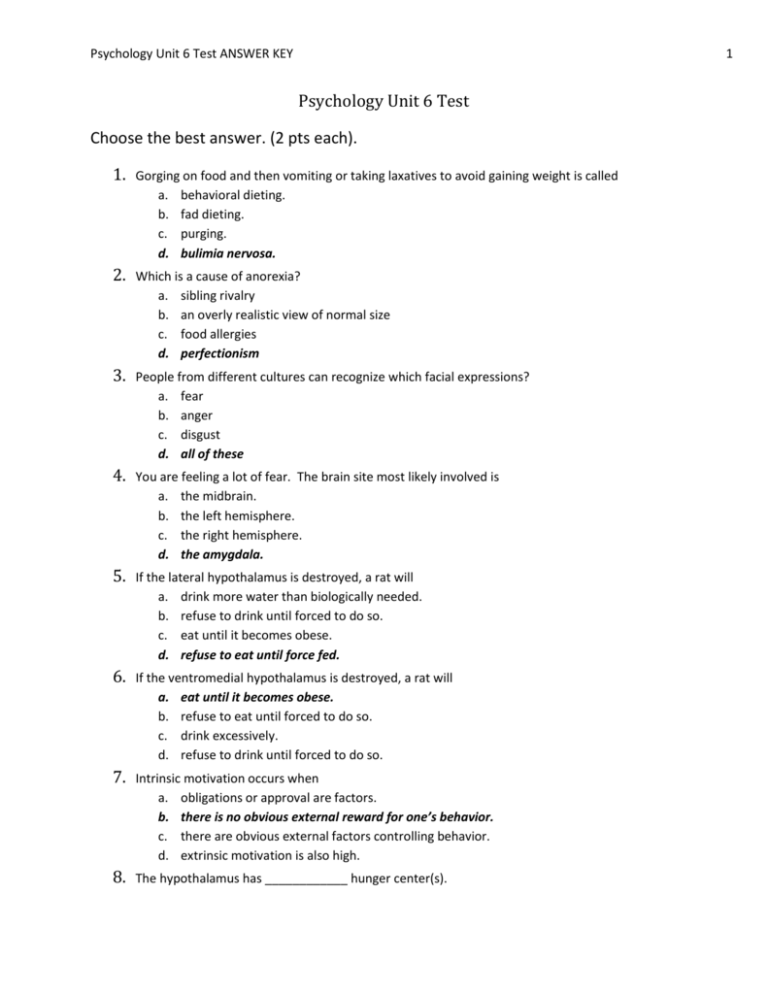
Psychology Unit 6 Test ANSWER KEY 1 Psychology Unit 6 Test Choose the best answer. (2 pts each). 1. Gorging on food and then vomiting or taking laxatives to avoid gaining weight is called a. behavioral dieting. b. fad dieting. c. purging. d. bulimia nervosa. 2. Which is a cause of anorexia? a. sibling rivalry b. an overly realistic view of normal size c. food allergies d. perfectionism 3. People from different cultures can recognize which facial expressions? a. fear b. anger c. disgust d. all of these 4. You are feeling a lot of fear. The brain site most likely involved is a. the midbrain. b. the left hemisphere. c. the right hemisphere. d. the amygdala. 5. If the lateral hypothalamus is destroyed, a rat will a. drink more water than biologically needed. b. refuse to drink until forced to do so. c. eat until it becomes obese. d. refuse to eat until force fed. 6. If the ventromedial hypothalamus is destroyed, a rat will a. eat until it becomes obese. b. refuse to eat until forced to do so. c. drink excessively. d. refuse to drink until forced to do so. 7. Intrinsic motivation occurs when a. obligations or approval are factors. b. there is no obvious external reward for one’s behavior. c. there are obvious external factors controlling behavior. d. extrinsic motivation is also high. 8. The hypothalamus has ____________ hunger center(s). Psychology Unit 6 Test ANSWER KEY a. b. c. d. 9. no control over total control over the most direct control over one The most critical physiological factor controlling hunger is the a. level of blood sugar. b. presence of stomach contractions. c. taste of food. d. presence of weakness or fatigue. 10. a. b. c. d. The maintenance of steady states of temperature and blood pressure are examples of thermostasis. homeostasis. intrinsic motivation. biological rhythm. 11. The employees at a factory were excellent workers until a week before Christmas when a rumor spread that economic conditions would force the plant to close in four days. The quality and quantity of work took a down turn as the workers spent time discussing among themselves the plausibility of the rumor and what they would do if it were true. Maslow would say that these workers were motivated by a. meta-needs. b. intrinsic motivation. c. esteem and self-esteem. d. safety and security. 12. Which theory of emotion holds the view that bodily changes PRECEDE emotion and that we experience an emotion AFTER our body reacts? a. the common sense theory b. the Cannon-Bard theory c. attribution theory d. the James-Lange theory 13. a. b. c. d. In hunger, a set point is similar to a body’s thermostat for blood sugar. the weight you maintain when you attempt to diet. related to the proportion of body fat your body normally maintains. determined by adult eating habits. a. b. c. d. What is the correct order of needs in Maslow’s hierarchy? physiological; esteem; safety; self-actualization; love and belonging self-actualization; physiological; safety; love and belonging; esteem physiological; safety; love and belonging; esteem; self-actualization self-actualization; safety; love and belonging; esteem; physiological 14. 15. According to Maslow’s theory, the basic needs include 2 Psychology Unit 6 Test ANSWER KEY a. b. c. d. physiological needs, safety, and security. safety, love, and belonging. physiological needs and belonging. security and esteem. a. b. c. d. Which theory holds that we are afraid because we run or are angry because we strike? attribution James-Lange Cannon-Bard cognitive a. b. c. d. At the top of Maslow’s hierarchy of motives is/are love and belonging. esteem and self-esteem. self-actualization. safety and security. 16. 17. 18. Which theory claims that emotions are organized in the brain and that emotional feelings and bodily expressions occur simultaneously? a. the common sense theory. b. the Cannon-Bard theory. c. attribution theory. d. the James-Lange theory. 19. A part of the nervous system that prepares the body for emergencies is the __________________ division. a. parasympathetic b. sympathetic c. somatic d. adaptive 20. a. b. c. d. A circadian rhythm refers to a cycle of sexual receptivity caused by hormone cycles. of bodily activity approximately 24 hours in length. of emotional arousal. during which various bodily systems are in phase. a. b. c. d. Which of the following is a characteristic of bulimia nervosa? Vomiting, laxatives, or diuretics are used to lose weight. There are repeated attempts to lose weight by severe dieting. It occurs equally in males and females. It is an adolescent growth phase that a few women go through and later disappears. 21. 22. Which of the following is an assumption of arousal theory? a. Zero level of arousal is the most desirable. b. High levels of arousal are most desirable. c. Optimal levels of arousal exist for each person. 3 Psychology Unit 6 Test ANSWER KEY d. Optimal levels of arousal exist for various activities. 23. a. b. c. d. Electrically stimulating the lateral hypothalamus will cause a rat to start eating. stop eating. start drinking. stop drinking. 24. The part of the autonomic nervous system responsible for restoring the body and conserving energy is the a. somatic nervous system. b. limbic system. c. parasympathetic division. d. sympathetic division. 25. a. b. c. d. Extrinsic motivation stems from obvious external factors. intrinsic motivation. primary drives. self-actualization. a. b. c. d. The need for achievement is greatest for behaviors leading to financial and material success. does not occur in primitive cultures. is defined as the desire to meet internalized standards of excellence. is greater in women than in men. a. b. c. d. Life-threatening weight loss due to self-inflicted starvation is called fasting. malnutrition. anorexia nervosa. hypoglycemia. 26. 27. 4

